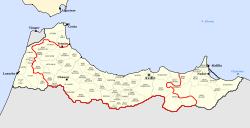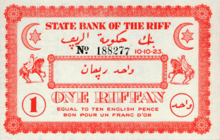Rif Republic
| Confederal Republic of the Tribes of the Rif | ||||||||||
| Tagduda n Arrif | ||||||||||
| ||||||||||
|
| ||||||||||
 Territory of Spanish Morocco under control of the Rif Republic (outlined in red) | ||||||||||
| Capital | Ajdir | |||||||||
| Languages | Riffian Berber | |||||||||
| Religion | Islam | |||||||||
| Government | Republic | |||||||||
| President | ||||||||||
| • | 1921–1926 | Muhammad Ibn 'Abd al-Karim al-Khattabi | ||||||||
| Prime Minister | ||||||||||
| • | 1923–1926 | Hajj Hatmi | ||||||||
| Historical era | Interwar period | |||||||||
| • | Established | September 18, 1921 | ||||||||
| • | Disestablished | May 27, 1926 | ||||||||
| Currency | Rif Republic riffan | |||||||||
| ||||||||||
Part of a series on the |
|---|
| History of Morocco |
 |
|
Related topics
|
|
|
The Republic of the Rif (Berber: ⵜⴰⵊⴷⵓⴷⴰ ⵏ ⴰⵔⵔⵉⴼ, Tagduda n Arrif; officially The Confederal Republic of the Tribes of the Rif) was a republic in northern Morocco that existed between 1921 and 1926. It was created in September 1921, when the people of the Rif revolted and declared their independence from Spanish occupation as well as from the Moroccan sultan Yusef.[1][2][3]
Profile
Its capital city was Ajdir, its currency the Rif Republic's Riffan, its national Independence Day was held on 18 September, and its total population was an estimated 550,000 people. The independence of the Rif was proclaimed on 18 September 1921, with Mohand Abd el-Krim as its president or leader. The Republic of the Rif was formally constituted 1 February 1923, with Abd el-Krim as head of state. Its prime minister, from July 1923 to 27 May 1926, was ben Hajj Hatmi and General Driss Riffi Temsamani was named Basha or Governor of the Rif. It was dissolved by Spanish and French occupation forces on 27 May 1926, after the long and bloody battles of the Rif War in which German-designed chemical weapons were used against the Berber populations by Spanish occupation forces.
History


The Berbers fiercely resisted both Spanish and French incursions into Morocco. However, the Berbers had been unable to consolidate power, and had continually returned to ethnic fighting and tribal division. The Great Revolt of 1912 against French rule ended in failure because the tribal alliances created during the Great Revolt disintegrated within months.
Muhammad Ibn 'Abd al-Karim al-Khattabi, previously a court judge, became the leader of the Berbers in the Rif. Having created a command and power structure, Abd el-Krim defeated the Spanish many times and drove them back to a few coastal outposts. He wanted to create a stable state for the Berbers to shield them from the long years of fighting. Abd el-Krim sent diplomatic representatives to London and Paris to try to establish diplomatic relations with Europe. This failed because the French feared that if the Rif gathered forces and weapons, it would expel the French from Morocco. Abd el-Krim's rhetoric concentrated on the right to freedom of all people, an unwelcome message to the European colonial forces.
In late 1925, the French and Spanish created a joint task force of half a million men supported by tanks and aircraft.[4] They bombarded the new Republic, sometimes the Spanish used German-designed chemical weapons. The Rif Republic collapsed in May 1926, but Rif guerrillas continued to fight until 1927.
See also
References
- ↑ Day, Richard B.; Gaido, Daniel. Discovering Imperialism: Social Democracy to World War I. BRILL. p. 549. ISBN 9004201564. Retrieved 14 September 2016.
- ↑ Wyrtzen, Jonathan. Making Morocco: Colonial Intervention and the Politics of Identity. Cornell University Press. p. 183. ISBN 9781501704246. Retrieved 14 September 2016.
- ↑ Hall, John G.; Publishing, Chelsea House. North Africa. Infobase Publishing. p. 62. ISBN 9780791057469. Retrieved 14 September 2016.
- ↑ Slavin, David H. (Jan 1991), "The French Left and the Rif War, 1924–25: Racism and the Limits of Internationalism", Journal of Contemporary History, 26 (1): 5–32, doi:10.1177/002200949102600101
Coordinates: 35°12′N 3°55′W / 35.200°N 3.917°W
